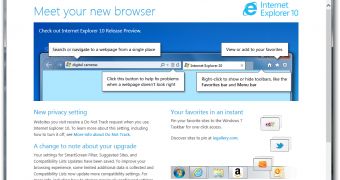Microsoft has recently released Internet Explorer 10 for Windows 7 preview, but despite all the criticism it has received in the last few months, the “Do Not Track” feature is still enabled by default.
Just like it happens on the Windows 8 platform, Microsoft ignores all the requests and keeps DNT turned on for all users who deploy the company’s in-house browser.
The reason is as simple as it could be, Microsoft explained: customers want more control over the information they send while browsing the web.
“IE10 continues our focus on helping consumers protect their privacy, which started in IE9 with features such as Tracking Protection. In Windows 8, ‘Do Not Track’ (DNT) is ‘on’ in the Express Settings at time of set-up, and IE10 in Windows 7 also sends a ‘Do Not Track’ signal to Web sites by default. Microsoft's customers have been clear that they want more control over how their personal information is used online,” Microsoft said in a press release.
Basically, the DNT option blocks websites from collecting information about the current browsing session, which is kind of worrying for all online advertisers.
Several companies have already requested Microsoft to disable this option, but the answer has always been the same: we won’t do that because our users need it.
Still, consumers who download and install the new Internet Explorer 10 for Windows 7 preview are provided with a notification at the first run, as well as with instructions on how to disable it.
“While ‘Do Not Track’ is a technology solution that’s still in its formative stages, it holds the promise of giving people greater choice and control of their privacy as they browse the Web. IE10 Windows 7 customers are notified of the ‘Do Not Track’ setting via IE10's first run welcome page, including instructions for how they can turn off ‘Do Not Track’ should they wish.”

 14 DAY TRIAL //
14 DAY TRIAL //